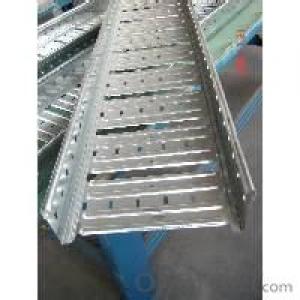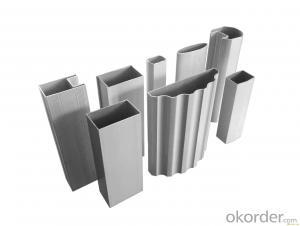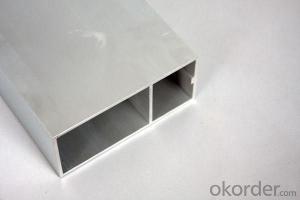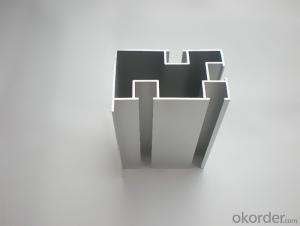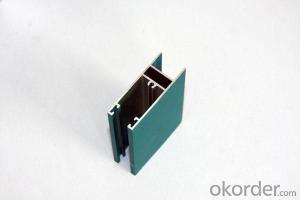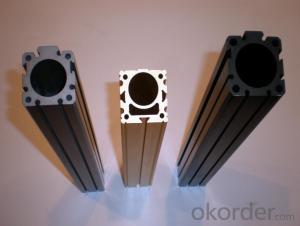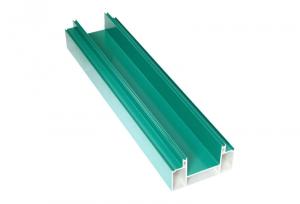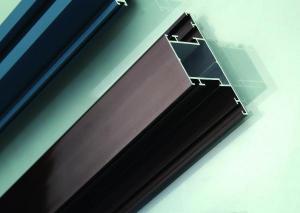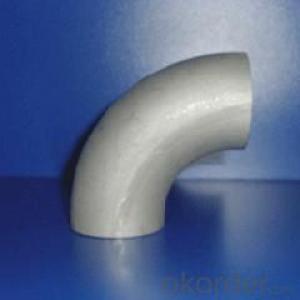Aluminum Extrusion Profiles T-Slot for Windows and Doors or Construction
- Loading Port:
- Shanghai
- Payment Terms:
- TT OR LC
- Min Order Qty:
- 1 m.t.
- Supply Capability:
- 1000 m.t./month
OKorder Service Pledge
OKorder Financial Service
You Might Also Like
Aluminium is a relatively soft, durable, lightweight, ductile and malleable metal with appearance ranging from silvery to dull gray, depending on the surface roughness. It is nonmagnetic and does not easily ignite. A fresh film of aluminium serves as a good reflector (approximately 92%) of visible light and an excellent reflector (as much as 98%) of medium and far infrared radiation. The yield strength of pure aluminium is 7–11 MPa, while aluminium alloys have yield strengths ranging from 200 MPa to 600 MPa. Aluminium has about one-third the density and stiffness of steel. It is easily machined, cast, drawn and extruded.
Aluminium alloys (or aluminum alloys; see spelling differences) are alloys in which aluminium (Al) is the predominant metal. The typical alloying elements are copper, magnesium, manganese, silicon, tin and zinc. There are two principal classifications, namely casting alloys and wrought alloys, both of which are further subdivided into the categories heat-treatable and non-heat-treatable.
Material | Alloy 6063,6061,6005or according to customer’s choice |
Temper | T3, T4, T5, T6 |
Surface | Anodize, electrophoresis, powder coating, PVDF coating, wood grain painting, matted, etc. |
Length | Coating 6.5 meters, Anodizing 6.5 meters, Mill finish 5-6 meters |
Application | Industrial, electrical equipment(TV set, air conditioner, refrigerator, computer), decoration,construction, transportation |
Custom Made | We can package following with customer's request. |
Products are exported to United States, Canada, U.A.E, Brazil, Mexico,Thailand, Vietnam, Nigeria etc, over 100 countries and regions all over the world.
FAQ:
1. What is the form of payment?
Normally 30% TT, L/C
2. Type of quotation?
FOB, CFR, CIF
3. Port of loading?
Shanghai port
4. Delivery time?
20 day after client’s deposit
- Q: What are the strategies to reduce the environmental footprint when utilizing aluminum profiles in construction projects?
- <p>To minimize the environmental impact of using aluminum profiles in construction, consider the following strategies: Use recycled aluminum whenever possible, as it requires significantly less energy to produce than new aluminum. Opt for energy-efficient manufacturing processes and choose suppliers with strong environmental credentials. Design for disassembly and recycling to facilitate the reuse of aluminum profiles at the end of their life. Implement sustainable construction practices that reduce waste and emissions. Finally, educate stakeholders about the importance of sustainable materials and encourage the adoption of eco-friendly practices throughout the construction process.</p>
- Q: What are the different bending and forming options for aluminum profiles?
- Aluminum profiles offer various options for bending and forming, each with its own benefits and applications. Some commonly used methods are as follows: 1. Cold bending: This widely employed technique involves bending the aluminum profile using external force, without the need for heat. Cold bending can be performed manually or with machinery like press brakes or rollers. It is suitable for creating simple shapes and can be cost-effective for low volume production. 2. Heat bending: By heating the aluminum profile to a specific temperature, it becomes more malleable and easier to bend. Heat bending is often utilized for complex or precise shapes that cannot be achieved through cold bending. Skilled operators and specialized equipment, like heating lamps or furnaces, are necessary to ensure accurate results. 3. Roll forming: This process gradually shapes the aluminum profile into the desired form by passing it through a series of rollers. Roll forming is ideal for creating continuous shapes or long lengths of profiles with consistent dimensions. It finds common applications in industries such as construction, automotive, and furniture manufacturing. 4. Stretch forming: In this method, the aluminum profile is clamped at its edges and stretched over a form or mold. Stretch forming allows for the creation of complex curves and contours, making it suitable for applications that require intricate designs or unique shapes. Aerospace, architectural, and automotive industries often use stretch forming. 5. Hydroforming: Hydroforming utilizes pressurized fluid to shape the aluminum profile into a mold. The fluid pressure forces the metal to conform to the shape of the mold, resulting in precise and high-quality formed parts. Hydroforming is particularly advantageous for creating lightweight and structurally efficient components, making it popular in the automotive and aerospace industries. These bending and forming options offer a wide range of possibilities for shaping aluminum profiles according to specific design requirements. The choice of method depends on factors such as the complexity of the desired shape, production volume, cost considerations, and the specific industry application.
- Q: Can aluminum profiles be used in lighting fixture manufacturing?
- Aluminum profiles are indeed suitable for the manufacturing of lighting fixtures. In the lighting industry, aluminum is widely employed because of its many advantageous qualities. It possesses light weight, durability, and corrosion resistance, which make it perfect for both indoor and outdoor lighting fixtures. By easily molding and manipulating aluminum profiles, one can create diverse designs and forms, thereby enabling innovative and imaginative lighting solutions. Moreover, these profiles can be coated or anodized, thereby enhancing their visual appeal and providing extra protection against damage. All in all, due to their versatility, functionality, and aesthetic appeal, aluminum profiles are highly favored in the manufacturing of lighting fixtures.
- Q: Are aluminum profiles capable of being tailored to fit the unique specifications of a construction project?
- <p>Yes, aluminum profiles can be customized to meet specific requirements of a building project. They offer versatility and flexibility, allowing for adjustments in size, shape, and design. Manufacturers can produce aluminum profiles with varying thicknesses, lengths, and finishes to suit the project's structural and aesthetic needs. Customization may include specific bends, cuts, or holes to ensure compatibility with other building components. This adaptability makes aluminum profiles a popular choice for various construction applications, from window frames to structural supports.</p>
- Q: This question asks for the standard specifications and measurements of aluminum profiles that are frequently utilized in construction projects.
- <p>Aluminum profiles used in construction come in various specifications and measurements. Commonly, they are categorized by series such as 6060, 6061, 6063, and 6082, each with different mechanical properties. Sizes can range from small profiles like 20x20mm to large ones like 200x200mm or more. Thicknesses typically vary from 1mm to 6mm, depending on the structural requirements. Lengths can be customized but are generally available in standard lengths such as 6 meters. The profiles are measured in terms of their width, height, and thickness, and they are designed to meet specific load-bearing and aesthetic needs in construction. It's important to consult with suppliers or construction specifications for the exact measurements required for a particular project.</p>
- Q: Can aluminum profiles be used for stadium seating?
- Yes, aluminum profiles can be used for stadium seating. Aluminum profiles offer numerous advantages for stadium seating, making them a popular choice in modern stadium construction. Firstly, aluminum profiles are lightweight, which makes them easier to install and transport. This allows for faster construction times and reduces the overall weight load on the stadium structure. Secondly, aluminum profiles are highly durable and resistant to corrosion, making them suitable for outdoor applications where the seating is exposed to various weather conditions. This ensures that the stadium seating will remain in good condition for a longer time, reducing the need for frequent repairs or replacements. Additionally, aluminum profiles can be easily customized and fabricated into different shapes and sizes to meet the specific design requirements of the stadium. This flexibility allows for the creation of unique seating arrangements and configurations to optimize the spectator experience. Furthermore, aluminum profiles offer excellent strength-to-weight ratio, providing structural stability and support for the seating. This ensures the safety and comfort of spectators during events. In conclusion, aluminum profiles are a versatile and practical choice for stadium seating due to their lightweight nature, durability, customization options, and strength. They offer numerous benefits that contribute to the overall success and functionality of a stadium seating system.
- Q: What role does glass curtain wall aluminum profile holder play?
- The subframe is formed by connecting the silicone structural adhesive with the glass and then connecting the plate with the aluminum alloy through the platen. The purpose of the subframe is to achieve the "hidden frame" purpose
- Q: This question asks about the various methods used to finish aluminum profiles, including painting and coating.
- <p>Aluminum profiles can be finished in several ways to enhance their appearance, durability, and functionality. Common methods include: 1. Anodizing, which provides a protective oxide layer and can be colored. 2. Powder coating, an electrostatic process that offers a durable and colorful finish. 3. Painting, which can be done with various types of paint for aesthetic or protective purposes. 4. Polishing, which gives a shiny, smooth surface finish. 5. Brushing, creating a textured, satin-like appearance. 6. Electroplating, which deposits a thin layer of metal onto the aluminum for decorative or protective reasons. Each method has its advantages and is chosen based on the specific requirements of the application.</p>
- Q: Are aluminum profiles weather-resistant?
- Yes, aluminum profiles are weather-resistant. Aluminum is known for its excellent corrosion resistance and ability to withstand various weather conditions such as rain, snow, UV radiation, and extreme temperatures. This makes aluminum profiles a popular choice for outdoor applications such as windows, doors, and outdoor furniture.
- Q: This question asks about the various types of aluminum profiles that are specifically used for the purpose of insulating exterior walls.
- <p>Aluminum profiles for exterior wall insulation are crucial for thermal efficiency and structural integrity. Common types include: 1. <strong>Aluminum Cladding Profiles</strong>: These cover the insulation and provide a weather-resistant barrier. 2. <strong>Aluminum Insulation Fin Profiles</strong>: Used to create a gap for insulation material between the wall and the cladding. 3. <strong>Aluminum Casing Profiles</strong>: These encase the insulation, providing a finished look and additional protection. 4. <strong>Aluminum Angle Profiles</strong>: Used for corners and edges to maintain structural integrity. 5. <strong>Aluminum Trim Profiles</strong>: For finishing touches and to cover gaps or seams. Each type serves a specific function in the insulation system, ensuring energy efficiency and a durable exterior wall construction.</p>
Send your message to us
Aluminum Extrusion Profiles T-Slot for Windows and Doors or Construction
- Loading Port:
- Shanghai
- Payment Terms:
- TT OR LC
- Min Order Qty:
- 1 m.t.
- Supply Capability:
- 1000 m.t./month
OKorder Service Pledge
OKorder Financial Service
Similar products
Hot products
Hot Searches
Related keywords
